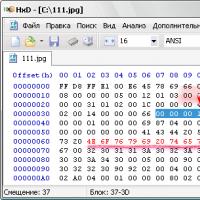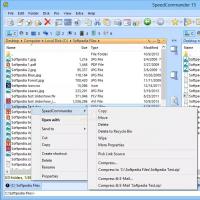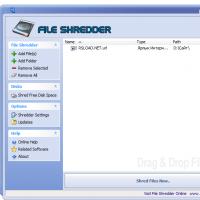Active filters on operational amplifiers. Active three-band filter based on NM2116. Bandpass and notch filters
Active RC filters are applied below 100 kHz. Application of positive feedback allows you to increase the Q-factor of the filter pole. In this case, the filter pole can be implemented on RC elements, which are much cheaper and in this frequency range are smaller in terms of inductance dimensions. In addition, the value of the capacitance of the capacitor included in the active filter can be reduced, since in some cases the amplifying element allows its value to be increased. The use of low-capacity capacitors allows you to choose their types with low losses and high stability of parameters.
When designing active filters, a filter of a given order is divided into links of the first and second order. The resulting frequency response will be obtained by multiplying the characteristics of all links. The use of active elements (transistors, operational amplifiers) makes it possible to exclude the influence of the links on each other and to design them independently. This circumstance greatly simplifies and reduces the cost of designing and configuring active filters.
First order active low pass filters
Figure 2 shows a schematic of an active RC first-order low-pass filter based on an operational amplifier. This circuit allows you to realize the pole of the transfer coefficient at zero frequency, the values of the resistance of the resistor R1 and the capacitance of the capacitor C1 can set its cutoff frequency. It is the capacitance and resistance values that will determine the bandwidth of this active filter circuit.
Figure 2. Schematic of an active RC first-order low-pass filter
In the circuit shown in Figure 2, the gain is determined by the ratio of resistors R2 and R1:
(1),and the value of the capacitance of the capacitor C1 is increased by the gain plus one times due to the Miller effect.
(2),It should be noted that this method of increasing the capacitance value leads to a decrease in the dynamic range of the circuit as a whole. Therefore, to this way increasing the capacitance of the capacitor is resorted to in extreme cases. Usually, they are bypassed with an integrating RC circuit, in which a decrease in the cutoff frequency is achieved by increasing the resistance of the resistor at a constant value of the capacitor's capacitance. In order to eliminate the influence of the load circuits, a buffer amplifier with a unity voltage gain is usually placed at the output of the RC circuit.

Figure 3. First-order RC low-pass filter circuit (RC-chain)
However, if the cutoff frequency of the low pass filter is low enough, it may be necessary to great importance capacitance of the capacitor. Electrolytic capacitors with significant capacitance are not suitable for creating filters due to the large variation in parameters and low stability. Ceramic-based capacitors with a high electrical constant ε , also do not differ in the stability of the capacitance value. Therefore, highly stable low-capacity capacitors are used, and their value increases in the active filter circuit shown in Figure 2.
Active second-order low-pass filters
The second-order active filter circuits are even more common, allowing for a greater slope of the frequency response compared to the first-order circuit. In addition, these links allow you to tune the pole frequency to a given value obtained by approximating the amplitude-frequency characteristic. The most widespread is the Sallen-Key scheme, shown in Figure 4.

Figure 4. Schematic of an active RC second-order low-pass filter
The frequency response of this circuit is similar to the frequency response of the second-order link of a passive LC filter. Its appearance is shown in Figure 5.

Figure 5. An approximate view of the amplitude-frequency response of the second-order link of an active RC low-pass filter
In this case, the pole resonance frequency can be determined from the formula:
and its quality factor:
The frequencies of zeros are ideally equal to infinity. In a real circuit, they depend on the design printed circuit board and the parameters of the resistors and capacitors used.
The Sallen-Key scheme allows you to simplify the selection of circuit elements as much as possible. Typically C1 and C2 have the same capacitance. Resistors R1 and R2 select the same resistance. First, they are set by the value of the capacities C1 and C2. As discussed above, they try to keep their capacities as small as possible. It is these capacitors that have the most stable characteristics. Then the value of R1 and R2 is determined:
Resistors R3 and R4 in the Sallen-Key circuit determine the voltage gain in the same way as in a conventional inverting amplifier circuit. In the active filter circuit, it is these elements that will determine the Q-factor of the pole.
In an active RC filter circuit, the amplifier is covered by both negative and positive feedback. The depth of positive feedback is determined by the ratio of resistors R1R2 or capacitors C1C2. If the quality factor of the pole is set due to this ratio (to abandon the equality of resistances or capacitors), then the operational amplifier can be covered with 100% negative feedback and provide a unity gain of the active element. This will simplify the second-order link diagram. A simplified schematic of a second-order active RC filter is shown in Figure 6.

Figure 6. Simplified Sallen-Key diagram
Unfortunately, with a unity gain, only the same values of the resistances R1 and R2 can be set, and the required quality factor can be obtained by the ratio of the capacitances. Therefore, the calculation begins with setting the nominal value of the resistors R1 = R2 = R. Then the capacitance can be calculated as follows:
(7),For many years, everyone has become accustomed to using an operational amplifier as an active element. However, in some cases it may turn out that the circuit on the transistor will either occupy a smaller area, or turn out to be more broadband. Figure 7 shows a diagram of an active low-pass filter, made on a bipolar transistor.

Figure 7. Schematic of an active RC low-pass filter on a transistor
The calculation of this circuit (elements R1, R2, C1, C2) does not differ from the calculation shown in Figure 6. The calculation of resistors R3, R4, R5 does not differ from the calculation of a conventional emitter stabilization stage.
Historical reference
The first frequency filters there were passive LC filters. Then, already in the 30s of the XX century, it was noticed that the feedback in the amplifying stages is capable of increasing the Q-factor of the LC circuits of radio amplifiers. One of the most common schemes for increasing the Q factor of a parallel LC circuit is shown in Figure 1.

Figure 1. Scheme for increasing the quality factor of a parallel oscillatory circuit
This feature is not widely used in LC circuits, since LC circuits allow constructive methods to provide the quality factor necessary for the implementation of most filter circuits operating at high frequencies. At the same time, positive feedback circuits used to increase the Q-factor of the circuits are self-excited and usually limit the dynamic range of the output signal due to the influence of amplifier stage noise.
A completely different situation has developed in the low-frequency region. These are mainly the frequencies of the audio range (20 Hz to 20 kHz). In this frequency range, the dimensions of the inductors and capacitors become unacceptably large. In addition, the losses of these radio-technical elements also increase, which in most cases does not allow obtaining the Q-factor of the filter poles necessary to implement the given one. All this led to the need to use amplifying stages.
date last update file 18.06.2018
Literature:
- Tietze W. Schenk K. Semiconductor Circuitry: A Reference Guide. Per. with him. - 12th edition. M .: Dodeka XXI, 2015 .-- 1784
- Tutorial
Short introduction
I continue to write spam on the topic of operational amplifiers. In this article I will try to give an overview of one of the most important topics related to op amps. So welcome active filters .Topic overview
You may have already come across models of RC, LC and RLC filters. They are quite suitable for most tasks. But for some purposes it is very important to have filters with flatter passband characteristics and steeper slopes. This is where we need active filters.To refresh your memory, let me remind you what filters are:
Low Pass Filter(LPF) - passes the signal below a certain frequency(also called cutoff frequency). Wikipedia
High Pass Filter(HPF) - passes the signal above the cutoff frequency. Wikipedia
Band Pass Filter- only passes a certain frequency range. Wikipedia
Notch Filter- delays only a certain frequency range. Wikipedia
Well, some more lyrics. Look at the frequency response (AFC) of the HPF. Don't look for anything interesting on this graph yet, just pay attention to the plots and their names:
The most commonplace examples of active filters can be found in the section "Integrators and Differentiators". But in this article we will not touch these schemes, because they are not very efficient.
Choosing a filter
Let's assume that you have already decided on the frequency you want to filter. Now you need to decide on the type of filter. More precisely, you need to choose its characteristics. In other words, how the filter will "behave".The main characteristics are:
Butterward filter- has the flattest characteristic in the passband, but has a smooth roll-off.
Chebyshev filter- has the steepest roll-off, but it has the most uneven bandwidth characteristics.
Bessel filter- has a good phase-frequency response and quite a "decent" roll-off. Counts the best choice if there is no specific task.
Some more information
Suppose you have completed this task as well. And now you can safely proceed to the calculations.There are several calculation methods. Let's keep it simple and use the simplest one. And the simplest is the "tabular" method. The tables can be found in the relevant literature. Whatever you look for for a long time, I will quote from Horowitz and Hill "The Art of Circuitry".
For LPF:

Let's just say that you could find and read all this in the literature. Let's move on specifically to the design of filters.
Payment
In this section I will try to briefly "go over" all types of filters.So, exercise 1... Construct a second-order low-pass filter with a cutoff frequency of 150 Hz according to the Butterward characteristic.
Let's get started. If we have a filter of the nth even order, this means that there will be n / 2 opamps in it. In this assignment - one.
LPF circuit:

For of this type calculation is taken into account that R1 = R2, C1 = C2.
We look at the plate. We see that K = 1.586... This will be useful to us a little later.
For a low-pass filter, it is true:
where, of course,
is the cutoff frequency.
After counting, we get. Now let's get down to the selection of elements. We decided on the OS - "ideal" in the amount of 1 piece. From the previous equality, we can assume that it is not important for us which element to choose "first". Let's start with a resistor. It is best that its resistance value be in the range from 2kOhm to 500kOhm. By eye, let it be 11 kOhm. Accordingly, the capacitance of the capacitor will become equal to 0.1 μF. For feedback resistors, the value R we take arbitrarily. I usually take 10 kΩ. Then, for the upper value of K we take from the table. Therefore, the lower one will have a resistance value R = 10 kOhm, and the top 5.8 kOhm.
Let's collect and simulate the frequency response.

Task # 2... Construct a fourth-order high-pass filter with a cutoff frequency of 800 Hz according to the Bessel characteristic.
We decide. Since the filter is of the fourth order, then the circuit will have two opamp. Everything is not at all complicated here. We simply cascade 2 HPF circuits.
The filter itself looks like this: 
The fourth-order filter looks like: 
Now the calculation. As you can see, for the fourth-order filter we have as many as 2 values TO... It is logical that the first is intended for the first stage, the second for the second. The values TO are equal to 1.432 and 1.606, respectively. The table was for low pass filters (!). To calculate the HPF, you need to change a few things. Odds TO remain the same anyway. For the Bessel and Chebyshev characteristics, the parameter changes
- normalizing frequency. It will be equal now:
For Chebyshev and Bessel filters, both for low frequencies and high frequencies, the same formula is valid:
Please note that you will have to count separately for each individual cascade.
For the first stage: 
Let be WITH= 0.01 μF, then R= 28.5 kΩ. Feedback resistors: lower, as usual, 10 kOhm; top - 840 ohms.
For the second stage: 
Let's leave the capacitance unchanged. Once C = 0.01 μF, then R= 32 kΩ.
We build the frequency response. 
To create a bandpass or notch filter, you can cascade a low-pass filter and a high-pass filter. But these types are often not used due to poor characteristics.
For bandpass and notch filters, you can also use the "tabular method", but there are slightly different characteristics.
I will immediately give a plate and explain it a little. So as not to stretch too much - the values are taken immediately for a fourth-order bandpass filter.
a1 and b1- calculated coefficients. Q- quality factor. it new parameter... The higher the Q value, the more “sharp” the drop will be. Δf- the range of passable frequencies, and the sampling is at the level of -3 dB. Coefficient α
is another calculation factor. It can be found using formulas that are fairly easy to find on the internet.
Okay, that's enough. Now the work assignment.
Task # 3... Construct a fourth-order bandpass filter based on the Butterward characteristic with a central frequency of 10 kHz, a bandwidth of 1 kHz and a gain at the center frequency point equal to 1.
Go. Fourth order filter. This means two op amps. I will give a typical scheme right away with the design elements. 
For the first filter, the center frequency is defined as: ![]()
For the second filter:
Specifically in our case, again from the table, we determine that the figure of merit Q= 10. Calculate the quality factor for the filter. Moreover, it should be noted that the quality factor of both will be equal.
Center frequency gain correction:
The final stage is the calculation of the components.
Let the capacitor be 10 nF. Then, for the first filter: ![]()
In the same order as (1), we find R22 = R5 = 43.5 kΩ, R12 = R4= 15.4 kΩ, R32 = R6= 54.2 Ohm. Just keep in mind that for the second filter we use
And lastly, the frequency response. 
The next stop is bandstop or notch filters.
There are several variations here. Probably the simplest is the Active Wien-Robinson Filter. A typical circuit is also a 4th order filter. 
Our last assignment.
Quest # 4... Build a notch filter with a center frequency of 90 Hz, a quality factor Q= 2 and a bandwidth gain of 1.
First of all, we arbitrarily choose the capacitance of the capacitor. Let's say C = 100 nF.
Let's define the value R6 = R7 = R:
It is logical that "playing" with these resistors, we can change the frequency range of our filter.
Next, we need to define intermediate coefficients. We find them through the quality factor.
Let's choose an arbitrary resistor R2... In this particular case, it is best that it is equal to 30 kOhm.
Now we can find resistors that will regulate the gain in the bandwidth. ![]()
![]()
And lastly, you must arbitrarily choose R5 = 2R1... In my circuit, these resistors have a value of 40 kOhm and 20 kOhm, respectively.
Actually, the frequency response: 
Almost the end
If you are interested in learning a little more, I can advise you to read Horowitz and Hill's "The Art of Circuitry".Also, D. Johnson "A handbook of active filters".
When working with electrical signals, it is often required to separate one frequency or band of frequencies from them (for example, to separate the noise and useful signals). Electrical filters are used for this separation. Active filters, unlike passive ones, include op-amps (or other active elements, for example, transistors, vacuum tubes) and have a number of advantages. They provide a better separation of the passband and attenuation bands; in them, it is relatively easy to adjust the unevenness of the frequency response in the transmission and attenuation regions. Also, in active filter circuits, inductors are usually not used. In active filter circuits, frequency responses are determined by frequency-dependent feedbacks.
Low pass filter
The low-pass filter circuit is shown in Fig. 12.
Rice. 12. Active low-pass filter.
The transmission coefficient of such a filter can be written as
 ,
(5)
,
(5)
 and
and  . (6)
. (6)
At TO 0 >>1

Transmission ratio  in (5) turns out to be the same as in the second-order passive filter containing all three elements ( R,
L,
C) (Fig. 13), for which:
in (5) turns out to be the same as in the second-order passive filter containing all three elements ( R,
L,
C) (Fig. 13), for which:

Rice. 14. Frequency response and phase response of the active low-pass filter for differentQ .
If R 1 = R 3 = R and C 2 = C 4 = C(in Fig. 12), then the transmission coefficient can be written as

Amplitude and phase-frequency characteristics of an active low-pass filter for different values of quality factor Q are shown in Fig. 14 (the parameters of the electrical circuit are selected so that ω 0 = 200 rad / s). The figure shows that with growth Q
A first-order active low-pass filter is implemented by the circuit in Fig. 15.

Rice. 15. Active low-pass filter of the first order.
The filter transmission coefficient is
 .
.
The passive analogue of this filter is shown in Fig. 16.
Comparing these transmission coefficients, we see that at the same time constants τ’ 2 and τ the modulus of the gain of the first-order active filter will be in TO 0 times more than that of the passive.

Rice. 17.Simulink-model of an active low-pass filter.
The frequency response and phase response of the active filter under consideration can be investigated, for example, in Simulink using the transfer function block. For the parameters of the electrical circuit TO R = 1, ω 0 = 200 rad / s and Q = 10 Simulink- the model with the transfer function block will look as shown in Fig. 17. Frequency response and phase response can be obtained using LTI- viewer... But in this case it is easier to use the command MATLAB freqs. Below is the listing for obtaining the frequency response and phase response graphs.
w0 = 2e2; % natural frequency
Q = 10; % quality factor
w = 0: 1: 400; % frequency range
b =; % vector of the numerator of the transfer function:
a =; % vector of the denominator of the transfer function:
freqs (b, a, w); % calculation and construction of frequency response and phase response
Frequency response characteristics of the active low-pass filter (for τ = 1c and TO 0 = 1000) are shown in Fig. 18. The figure shows that with growth Q the resonant nature of the amplitude-frequency characteristic is manifested.
Let us construct a low-pass filter model in SimPowerSystems using the OU block we created ( operationalamplifier), as shown in Figure 19. The op-amp block is non-linear, so in the settings Simulation/ ConfigurationParametersSimulink to increase the speed of calculation, you need to use the methods ode23tb or ode15s... It is also necessary to choose the time step wisely.

Rice. 18. Frequency response and phase response of the active low-pass filter (forτ = 1c).
Let be R 1 = R 3 = R 6 = 100 Ohm, R 5 = 190 Ohm, C 2 = C 4 = 5 * 10 -5 F. For the case when the source frequency coincides with the natural frequency of the system ω 0 , the signal at the filter output reaches its maximum amplitude (shown in Fig. 20). The signal is a steady-state forced oscillation with the frequency of the source. The graph clearly shows the transient process caused by switching on the circuit at the moment in time. t= 0. Also, the graph shows deviations of the signal from the sinusoidal shape near the extremes. In Fig. 21. shows an enlarged part of the previous graph. These deviations can be explained by the op-amp saturation (the maximum allowable voltage values at the op-amp output are ± 15 V). Obviously, with an increase in the amplitude of the source signal, the region of signal distortion at the output also increases.

Rice. 19. Model of an active low-pass filter inSimPowerSystems.

Rice. 20. Signal at the output of the active low-pass filter.

Rice. 21. A fragment of the signal at the output of the active low-pass filter.
Active filters are based on amplifiers (usually op amps) and passive RC filters. Among the advantages of active filters in comparison with passive filters should be highlighted:
· Lack of inductors;
· Better selectivity;
· Compensation for the attenuation of useful signals or even their amplification;
· Suitability for implementation in the form of IC.
Active filters also have disadvantages:
¨ energy consumption from the power source;
¨ limited dynamic range;
¨ additional nonlinear signal distortion.
Note also that the use of active filters with op amps at frequencies above tens of megahertz is difficult due to the low unity gain frequency of most op amps of widespread use. The advantage of active op-amp filters is especially evident in the most low frequencies, up to fractions of a hertz.
In the general case, we can assume that the op-amp in the active filter corrects the frequency response of the passive filter by providing different conditions for the passage of different frequencies of the signal spectrum, compensates for losses at specified frequencies, which leads to steep drops in the output voltage on the slopes of the frequency response. For these purposes, a variety of frequency-selective operating systems are used in the OA. In active filters, the frequency response of all types of filters is obtained: low pass (LPF), treble(HPF) and bandpass (PF).
The first stage in the synthesis of any filter is the setting of the transfer function (in operator or complex form), which meets the conditions of practical feasibility and at the same time ensures that the necessary frequency response or phase response (but not both) of the filter is obtained. This step is called filter approximation.
An operator function is a ratio of polynomials:
K ( p) = A ( p) / B ( p),
and is uniquely defined by zeros and poles. The simplest polynomial for the numerator is a constant. The number of poles of the function (and in active filters on an op amp, the number of poles is usually equal to the number of capacitors in the circuits that form the frequency response) determines the order of the filter. The order of the filter indicates the decay rate of its frequency response, which for the first order is 20dB / dec, for the second - 40dB / dec, for the third - 60dB / dec, etc.
The approximation problem is solved for a low-pass filter, then using the frequency inversion method, the obtained dependence is used for other types of filters. In most cases, the frequency response is set, taking the normalized transfer coefficient:
![]() ,
,
where f (x) - filtration function; - normalized frequency; - cutoff frequency of the filter; e is the permissible deviation in the passband.
Depending on which function is taken as f (x), filters (starting from the second order) of Butterworth, Chebyshev, Bessel, etc. are distinguished. Figure 7.15 shows their comparative characteristics.

The Butterworth filter (Butterworth function) describes the frequency response with the most flat part in the passband and a relatively low roll-off rate. The frequency response of such a low-pass filter can be represented as follows:
where n is the order of the filter.
The Chebyshev filter (Chebyshev function) describes the frequency response with a certain unevenness in the passband, but not with a greater decay rate.
The Bessel filter is characterized by a linear phase response, as a result of which signals whose frequencies lie in the passband pass through the filter without distortion. In particular, Bessel filters do not produce outliers when processing rectangular waveforms.
In addition to the listed approximations of the frequency response of active filters, others are known, for example, the inverse Chebyshev filter, the Zolotarev filter, etc. Note that the active filter circuits do not change depending on the type of frequency response approximation, but the ratios between the nominal values of their elements change.
The simplest (first order) HPF, LPF, PF and their LFC are shown in Figure 7.16.
In these filters, a capacitor that determines the frequency response is included in the feedback circuit.
For a high-pass filter (Figure 7.16a), the transmission coefficient is:
 ,
,
The frequency of conjugation of the asymptotes is found from the condition, whence
![]() .
.
For a low-pass filter (Figure 7.16b) we have:
 ,
,
![]() .
.
The PF (Figure 7.16c) contains elements of a high-pass filter and a low-pass filter.

You can increase the slope of the LFC rolloff by increasing the order of the filters. Active LPF, HPF and PF of the second order are shown in Figure 7.17.
The slope of their asymptotes can reach 40dB / dec, and the transition from low-pass filter to high-pass filter, as can be seen from Figures 7.17a, b, is carried out by replacing resistors with capacitors, and vice versa. In the PF (Figure 7.17c) there are elements of a high-pass filter and a low-pass filter. The transfer functions are equal:
¨ for LPF:
 ;
;
¨ for HPF:

 .
.
For the PF, the resonant frequency is:
 .
.
For the low-pass filter and high-pass filter, the cutoff frequencies are respectively equal:
![]() ;
;
![]() .
.
Quite often, second-order PFs are implemented using bridge circuits. The most common are double T-shaped bridges, which "do not pass" the signal at the resonant frequency (Figure 7.18a) and Wien bridges, which have the maximum transfer coefficient at the resonant frequency (Figure 7.18b).

Bridge circuits are included in the PIC and OOS circuits. In the case of a double T-bridge, the feedback depth is minimal at the resonance frequency, and the gain at this frequency is maximum. When using the Wien bridge, the amplification at the resonance frequency is maximal, because the maximum depth of the POS. At the same time, in order to maintain stability, the OOS depth introduced with the help of resistors and must be greater than the PIC depth. If the depths of the POS and OOS are close, then such a filter can have an equivalent quality factor Q "2000.
The resonant frequency of the double T-bridge at and ![]() , and the Wien bridge at
, and the Wien bridge at ![]() and
and ![]() , is equal to
, is equal to ![]() , and it is chosen based on the stability condition
, and it is chosen based on the stability condition ![]() since the transmission coefficient of the Wien bridge at a frequency is 1/3.
since the transmission coefficient of the Wien bridge at a frequency is 1/3.
To obtain a notch filter, a double T-shaped bridge can be included as shown in Figure 7.18c, or the Wien bridge can be included in the OOS circuit.
To build an active tunable filter, a Wien bridge is usually used, in which the resistors are made in the form of a double variable resistor.
It is possible to build an active universal filter (LPF, HPF and PF), a variant of the circuit of which is shown in Figure 7.19.

It includes an adder on an op-amp and two low-pass filters of the first order on an op amp and, which are connected in series. If ![]() , then the coupling frequency
, then the coupling frequency ![]() ... The LFC has an asymptote slope of the order of 40dB / dec. The universal active filter has good parameter stability and high quality factor (up to 100). In serial ICs, a similar filter design principle is often used.
... The LFC has an asymptote slope of the order of 40dB / dec. The universal active filter has good parameter stability and high quality factor (up to 100). In serial ICs, a similar filter design principle is often used.
Gyrators
The gyrator is called electronic device transforming impedance reactive elements. Usually this is a capacitance-to-inductance converter, i.e. equivalent to inductance. Gyrators are sometimes called inductor synthesizers. Wide use gyrators in an IC is explained by the great difficulties in manufacturing inductors using solid-state technology. The use of gyrators makes it possible to obtain a relatively large inductance with good weight and dimensions.
Figure 7.20 shows electrical circuit one of the variants of the gyrator, which is a repeater at the OA, covered by the frequency selective POS (s).

Since the capacitance of the capacitor decreases with an increase in the signal frequency, the voltage at the point a will increase. Together with it, the voltage at the output of the op-amp will increase. The increased voltage from the output through the PIC circuit goes to the non-inverting input, which leads to a further increase in the voltage at the point a, and the more intense, the higher the frequency. Thus, the voltage at the point a behaves like the voltage across an inductor. The synthesized inductance is determined by the formula:
![]() .
.
The quality factor of the gyrator is defined as:
![]() .
.
One of the main problems in gyrators is the difficulty in obtaining the equivalent of an inductor in which both pins are not connected to a common bus. Such a gyrator is performed on at least four op amps. Another problem is the relatively narrow range of operating frequencies of the gyrator (up to several kilohertz for a widespread op amp).
While developing the "radio controlled relay" I decided to use the frequency method of coding control commands. At the same time, it was decided to build the filter on the op-amp, since the op-amp unit that was not yet used was still in the case. But I haven't finished fantasizing on this yet, I thought a little and decided that you can still save on details using the elements that are in stock. This led to the writing of this article "calculation of a bandpass filter on an op amp". Digging through the books, collecting all necessary information compiled an algorithm for calculating the filter with unipolar power supply... But more on that later, and now there is not much theory.
All filters are divided into: active filters, which use both passive (resistors and capacitors) and active (transistors, microcircuits) elements to form the frequency response of a given type, and passive filters, which use only passive (resistors and capacitors) elements to form a frequency response of a given type. Now let's talk about bandpass filters.
A bandpass filter is so called because it only allows the filter to pass through. frequency range to which it is tuned, while frequencies outside this range are attenuated. Any bandpass filter has several main parameters that determine its characteristics: passband (the band in which the signal passes through the filter has the least attenuation), the attenuation band (the band in which the signals are attenuated), the gain (the filter characteristic, which is responsible for how many times the signal will be boosted or attenuated in the passband).
An ideal bandpass filter has a rectangular passband, but in practice this cannot be achieved, and one can only approach this shape to some extent. A real filter is unable to completely stop frequencies outside the desired frequency range, as a result there is an area near the boundaries of the specified range where the signal is only partially attenuated. This area is called the slope of the filter, and is measured in "dB" of attenuation per octave.
The principle of operation of the bandpass filter is based on changing the gain depending on the frequency of the input signal. The main one in the filter is an RC-circuit, included in the feedback circuit, which, when the frequency changes, affects the gain. Well, I think that's enough theory, let's move on to the calculations.
We will make the calculation according to the diagram below. Elements R1-R3 and C1, C2 - define the bandwidth and gain. R4, R5 - shift of the operating point, it is necessary for power supply from a unipolar source. The op-amp microcircuit acts as an active element and must be connected according to the Datasheet. Below the diagram in the pictures is the calculation of the bandpass filter on the op-amp, but you can also use the calculation files in Mathcad 14 and the models in.
Op-amp bandpass filter circuit


This filter can be used in light and music devices, radio controls, sensors and so on.
List of radioelements
| Designation | Type of | Denomination | Quantity | Note | Shop | My notebook |
|---|---|---|---|---|---|---|
| A | Operational amplifier | LM358 | 1 | Into notepad | ||
| C1, C2 | Capacitor | 3300 pF | 2 | Into notepad | ||
| R1 | Resistor | 3.3 k Ohm | 1 | Into notepad | ||
| R2 | Resistor | 240 Ohm | 1 | Into notepad | ||
| R3 | Resistor | 1.5 mΩ | 1 | Into notepad | ||
| R4 | Resistor |
 Free software for working with the network
Free software for working with the network How the password generator works
How the password generator works Recording video with sound from a computer screen: software overview Copying a computer screen program
Recording video with sound from a computer screen: software overview Copying a computer screen program Getting Started with Mozilla Firefox - Download and Install
Getting Started with Mozilla Firefox - Download and Install Best free hexadecimal editors (hex) Recover archives in WinRAR
Best free hexadecimal editors (hex) Recover archives in WinRAR A guide to file managers for Windows
A guide to file managers for Windows Free program to permanently delete files File Shredder screenshots File shredder 2
Free program to permanently delete files File Shredder screenshots File shredder 2